#ADASiteCompliance
Explore tagged Tumblr posts
Text
How To Avoid a Website Accessibility Lawsuit
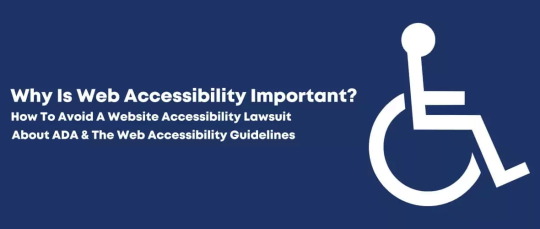
Every day, thousands of people are unable to use and interact with websites because of web accessibility issues. This can lead to a website accessibility lawsuit for you or your company. Over the past few years, certain regulations and guidelines to prevent this have emerged – more specifically, the Americans With Disabilities Act (ADA).
The Act was carried as a civil rights legislation, which passed in the US to protect the rights of people with disabilities, as well as prohibit any discrimination against them. As per the ADA website rules, all people with disabilities have to have equal opportunities to participate in programs, receive services, seek knowledge, and express themselves freely.
Why Is Web Accessibility Important?
Website accessibility refers to the ability of people with a wide range of physical and mental disabilities to access websites, products, systems, services, and facilities featured on a website. For instance, web accessibility means that visually impaired or blind people can purchase tickets, use apps, recharge transportation cards, and use other services offered online.
Web content should be accessible to people, even ones using screen readers and other assistive technologies and automated tools. In times when around 1 in 5 people in the U.S. lives with one or more disabling conditions, statistics show that there are more than 50 million people in the United States and around 1.3 billion around the world who have a certain form of disability.
At the same time, improved digital accessibility benefits everyone. The features that would be designed for 20% of the population can also be used by the other 80% – we all know that anyone can be affected by a disability, which is why equal access matters. Adhere to these new standards for the disabled or you are likely to face a website accessibility lawsuit soon.
Digital Accessibility Features That Can Benefit Everyone
Some of the most important digital accessibility features that can benefit everyone include the following:
Text-to-Speech and Voice Recognition features, help people access online services on a mobile device when driving, or when their hands are full.
Features that enable captions on media content, can help when you are in a noisy environment or in situations when you don’t want to distract others.
An option to easily magnify text by screen magnifiers, which can help disabled and people with vision impairments and difficulties, but also people who suffer from temporary eye injuries.
Besides regular business compliance, an ADA site can improve the overall marketing of the company, especially when using the right tools that are known as popular in this manner. These can assist you in avoiding a website accessibility lawsuit.
About ADA & The Web Accessibility Guidelines
Web accessibility guidelines have existed for two decades. They aim to bring usability and user experience design together, removing barriers for people with disabilities and enabling more users to complete tasks online.
Generally speaking, these guidelines are designed to provide a sufficient level of detail for any person interacting on the web. Some guidelines involve discrete and identifiable criteria (for example, embedding images and link areas with appropriate text) while others require greater amounts of professional discretion (the use of code to improve navigability, predictability, compatibility with certain software, etc.).

Americans With Disabilities Act (ADA)
Establishing a legal framework around digital accessibility ensures that companies give equal access to content to disabled users, and make their services accessible to a large audience. Over the past decade, companies have been rushing to embrace accessibility in order to strengthen their financial and ethical benefits. The legal requirement came into effect in 2010, known as the Americans with Disabilities Act (ADA).
This legal framework outlines all the digital accessibility requirements for every company profile in the United States. Basically, ADA compliance ensures that a set of laws is put in place to prevent any discrimination against people with disabilities. It is applicable in all areas of public life including work, school, education, and transportation services. Established by the Department of Justice, ADA compliance requires websites to enable people to use the Internet as well as online services.
Who Needs To Follow The ADA Requirements?
There are three main titles within ADA, where Title I applies to all businesses with at least 15 full-time employees. Title II of the ADA applies to state and local government compliance. Lastly, ADA Title III refers to most businesses as well as non-profit business entities in the “accommodation” and “public spaces” categories.
Online services and digital information are also considered public accommodations and require ADA compliance. Below is a summarized list of companies, businesses, and organizations that are required to comply and are at risk of ADA lawsuits in case of violations:
State and local government offices
Private business entities employing 15 or more people
Corporations that operate for the benefit of the public
Banking Institutions
Hotels and travel/tour agencies or businesses
Hospitals and healthcare institutes
Schools, universities, and educational institutions.
WCAG
A document known as the Web Content Accessibility Guidelines (WCAG) is what has been the globally accepted standard defined by the World Wide Web Consortium (W3C). The regulations spread through three levels of accessibility for both online and digital services, including:
Level A is the minimum level of accessibility that is required for individuals to make digital content accessible to people with disabilities.
Level AA is the medium level of accessibility that is required for individuals to access and interact with digital content, navigating it without any barriers.
Level AAA is the maximum level of accessibility that is required for individuals, where digital content needs to be accessed but also has an additional interface layer, providing the most convenient experience.
Many types of web content are unable to reach Level AAA. On the other hand, Level AA compliance is the minimum required level in order to make a website accessible.
Why Are WCAG 2.0 And 2.1 Created?
The WCAG 2.0 and WCAG 2.1 guidelines have been created to provide a clear methodology and a unique standard for digital accessibility that meets the needs of all individuals, companies, and governments. The standard applies to a broad range of web technologies, implemented by a set of web development and web design techniques, as well as tested by a range of automated tools.
In times when many businesses or website owners don’t understand how people interact with their websites or mobile apps, having an ADA website that conforms to the regulations can help you prevent accessibility lawsuits.
Moreover, a website designed as per the latest website usability and accessibility reviews is a good way to expand your reach to a broader target audience, improve your marketing efforts, and ensure that every user has equal access to your information, products, or services.
Here, it is important to prepare the digital content including text, audio, video, graphics, and illustrations with alternatives, as well as use formats that are supported by the users’ assistive technologies.
Still, the remaining challenges include the lack of skilled developers that are trained in accessibility, as well as the lack of awareness about ADA compliance and how to build an ADA-compliant website or mobile app and avoid a website accessibility lawsuit.
U.S. Rehabilitation Act
The U.S. Rehabilitation Act is a federal law that prohibits any discrimination on the basis of disability in programs conducted by federal agencies. The rule applies to programs receiving federal financial support and includes the following two sections designed for website accessibility compliance:
Section 504 of the U.S. Rehabilitation Act, protects children and adults with disabilities from discrimination in schools and workplaces. There are specific accessibility criteria for online educational resources.
Section 508 of the U.S. Rehabilitation Act, where government bodies and federal services are required to make electronic and information technology (EIT) accessible to all people, including disabled people.
ADA Lawsuits Are On The Rise: Is Your Website At Risk?
While many still don’t understand what accessibility is and why it is important, advocates are everywhere writing guides and helping website owners understand and implement these digital accessibility rules. However, website accessibility lawsuits are on the rise and make the news nearly every day in the United States. This happens mostly because there are still no enforceable regulations for website accessibility.
The set of regulations is under Section 508 by law, where federal websites in the U.S. are required to check and meet these standards. In order to prevent ADA lawsuits, most simply follow Section 508 or the WCAG 2.0 and 2.1 AAA guidelines.
Accessibility laws are changing and are different in many countries. Besides the U.S., the UK and Canada are also starting to enforce accessibility. However, we will stick to the site accessibility lawsuits and how to prevent them by complying with the law while making your website accessible.

Popular Website Compliance Lawsuits & Settlements
Statistics from Seyfarth show that in 2018 alone, there were a total of 2258 website accessibility lawsuits to the federal court, which was a 177% jump from the previous year. In 2019, the number of cases also increased, most of which were in the retail, food service, entertainment and leisure, travel/hospitality, self-service, and real estate industries.
One of the first federal court lawsuits filed against a big name occurred in 2006, when the National Federation of the Blind (NFB) as the plaintiff sued Target, a U.S. supermarket chain, for its inability to comply with ADA rules.
In the hospitality industry, Domino’s Pizza was one of the companies which received a lawsuit filed in federal court. In 2016, a visually impaired man sued the popular chain because his screen reader was incompatible with their mobile app, so the device could not read aloud its contents.
In 2012, the National Association of the Deaf (NAD) filed a lawsuit against Netflix, for not providing closed captions in its online TV and movie streaming services. The plaintiff has taken legal action against the popular streaming service and the case quickly arrived at federal court.
Education facilities have not been exempt from lawsuits, too. Two federal class-action lawsuits were filed against Harvard and MIT by the National Institute of the Deaf (NAD) for not providing captions in their online content and courses. After four years of legal action on federal court grounds, Harvard was made liable to pay $1.5 million in litigation and attorney fees.
In most of these cases, big names could have saved themselves from litigation costs and bad publicity by simply adding some accessibility features to their website to reduce the risk of such lawsuits.
Recent posts show that even today, the number of lawsuits filed against companies in federal court actions is increasing. Many small to medium-sized businesses are on the radar, too. Among all states, New York, California, and Florida seem to be hotbeds for legal ADA-related lawsuits.
How to Comply With The Web Content Accessibility Guidelines
If you want to prevent an ADA lawsuit, the only route is to plan for, design, as well as build an accessible website. This form of inclusive design should optimize content and help the visually impaired, as well as people with other disabilities, to use and interact with your website.
In fact, every business with a website, mobile app, or internet software application should hire an accessibility specialist to go over the site and ensure full ADA compliance. In order to have an ADA-compliant business website optimized for people with disabilities, you will need to hire these experts who know what needs to be changed and how to ensure compliance.
For instance, if you apply ARIA with HTML5 or your image alt tags are not written properly, you could be facing a lawsuit. However, the source of most ADA lawsuits is the actual inability to access web pages or mobile apps, especially for visually impaired or blind people who use assistive technologies.
There are some builders that are integrated within content management systems and help website owners make the site ADA-compliant. Elementor, a popular WordPress theme-building, and page design plugin are one of them. The plugin helps incorporate parallax, dynamic content, and animations that comply with the accessibility guidelines. There is also the creation of new themes, headings, and footers with full developer control.
What Can You Do To Create An Effective ADA Website And Comply With WCAG: Checklist
The WCAG guidelines outline a set of principles and techniques that make web content “perceivable, operable, understandable, and robust.” In other words, users should be able to access content, use interactive elements, navigate through web pages and apps, and use the content on their device of choice.
There are three vital ways to achieve the goals for website accessibility:
Correct use of HTML, CSS, and JavaScript
Organization of content properly and logically, so that both humans and assistive tools can interpret its layout, including the use of text alternatives for visual content (YouTube is a good example of this – the platform was designed to automatically add captions to videos uploaded on the network).
Extra attributes are added to HTML and other code so that assistive devices can be used effectively, complying with the existing web accessibility standards.
From Braille readers used for hearing and reading text or images to screen readers and magnifiers for blind or visually impaired users and keyboard/joystick navigators for people who can’t use a mouse or other input controls, all of these ways ensure compliance.
How Do You Test Web Accessibility Across Different Devices?
There are two main ways to test how content shows on a website or mobile app.
The first is automated testing, which involves running a test against the latest WCAG principles. With this method, you can identify 20% to 30% of the compliance issues. That is why developers use it as a starting point when familiarizing themselves with the WCAG requirements set by the U.S. Department of Justice.
Second is manual testing, which is obviously more detailed and complex and will deliver the BEST RESULTS. Here, the testing should identify areas of partial compliance with regulations. Common tests use keyboard-only testing schemes to identify where certain issues occur for people who cannot use mouse or touch interfaces. We specialize in manual testing and correcting all errors.
Within manual testing, there is also the practice of testing pages and case scenarios with a screen reader or an emulator that shows how a webpage will respond to a user who wants to access content with text-to-speech technology.
Run a FREE SITE SCAN with us today to test the accessibility of your website.
Facing An ADA Lawsuit? Here Are 4 Steps To Make Your Site Accessible
As we mentioned above, the purpose of the ADA is to ensure that any disabled person has the same opportunity and rights as others in ensuring that digital content is accessible. Violating ADA can land you a lawsuit and some serious fines (up to $20,000 or more), and the best way to avoid potential litigation for a violation is through the four steps below.
Identify Your Barriers – Examining your business site and any of its features that could be a barrier to people with disabilities is usually the best place to start. Know that having more text is never a bad idea, as more people use assistive technologies nowadays. Put yourself in the shoes of an impaired person and try to understand whether your site is designed so you can freely navigate through its pages.
Understand The Requirements – Understanding the ADA requirements is equally important for everyone. New websites are already being designed with web accessibility in mind, and seeing what these rules require can only help you visualize and plan for new content in a better way.
Train Your Staff To Assist – If you work with a web design specialist, make sure that person is familiar with WCAG and able to align your content and marketing tools to support the ADA laws.
Hire A Professional – If you have multiple websites, or find it difficult to optimize your company website to comply with web accessibility laws, you can always seek our professional assistance to prevent an ADA lawsuit.
Hiring expert ADA consultants to audit the level of your website’s accessibility, provide guidance on remediation, and maintain accessible design is recommended if you want to lower the risk of a potential lawsuit.
Final Words
The bottom line of complying with web accessibility is that it offers a number of ways to build a reputation but also targets a broader audience. Users deserve to have equal access to content online, and many of their common tasks have been identified by regulators as essential for modern living. Therefore, it is vital to take advantage of these services and opportunities, and doing that would also prevent accessibility lawsuits.
Every organization, whether large or small, should ensure that they are aware of their accessibility obligations. In doing so, they will mitigate any risks of facing an accessibility lawsuit, but also maximize their revenue potential. In the end, wider accessibility equals a better online experience for everyone.
How good is your web accessibility? If you need help making your company website or mobile app accessible and complying with U.S. Federal regulations, contact us today. We will carry out a full audit and suggest the best ways to help your business site ensure full ADA compliance and prevent lawsuits.
#adasitecompliance#web accessibility#ada lawsuits#web accessibility lawsuit#ada web accessibility solution
3 notes
·
View notes
Text
How to Make Sure Your Website Is ADA-Compliant
There are several different pieces of legislation that were passed in the last decade to help both regulate and improve the way that websites work for the public. Just last year, GDPR (General Data Protection Regulation) laws were passed in Europe, which helps to regulate how private information is used in marketing, for example. Source: https://www.entrepreneurshipsecret.com/how-to-make-sure-your-website-is-ada-compliant/ Read the full article
0 notes
Photo

Remember what the #Pilgrams did to the #NativeAmericans, that's why they celebrate #Thanksgiving! Dumb AF! You know they did to us #Hawaiians? They stole our land, our culture and our steez! They also brought these damn Kiawe trees to disconnect us from our own Aina so we had to wear slippahs! As all of #IT and #TeamRetards continue to disobey this #QueenBitch #Transformer #Shapeshifting #KahunaNui, and refuse to surrender to #AllThatIs... I AM IT, I OWN IT & THEY BETTER LEARN TO OBEY YOU THIRSTY HOES! The #ArtOfWar by #SunTzu divide and conquer! If they continue to disobey me, they will all be dead and white supremacy won, again, with their black magic trickery, misuse of technology and turning our friends, families and ohana against one another. I refuse to participate... "Use IT or Lose IT" is a TRAP & so is "We're just filming a movie, we'll pay you bread crumbs to participate in the reality of the longest crucifixion of Ra the Sun GOD!" Breach Of Contract Invocation: "I AM, I AM, I AM canceling any and all contracts with the dark. I was tricked, mislead and lied to and or lured into a trap by #CGI, #Holograms or the #Vatican broadcasting system a.k.a. #IT also known as #GameBoys to misrepresent my real spirit guides and the one true voice of GOD! If the @cia had intelligence @google mistranslations are null & void and they better call @randcpmk & do some PR damage control because when the American's With Disabilities find out you've been withholding technology & misusing IT on me without consent, watch out when @adasitecompliance @aapdofficial @mia.mingus files a class action law suit against the @cia, who we all know has been trafficking our children & running the drug game! You're all being cut off because all the ingredients come from where they worship the ONE true GOD with many names! #Allah Guess who's the new #illuminati? The all seeing eye of Amun Ra!👁➕🔯 The whole multiverse is online and the real story is being written and translated in every country on this prison planet hacked by the Cabal. The illuminati's job was to protect the secret of Jesus's line continued, but they were infiltrated and turned Satanic. No excuses, now you know... (at Prince Buddha International) https://www.instagram.com/p/CEDNcquMSnc/?igshid=fw21yra605tu
#pilgrams#nativeamericans#thanksgiving#hawaiians#it#teamretards#queenbitch#transformer#shapeshifting#kahunanui#allthatis#artofwar#suntzu#cgi#holograms#vatican#gameboys#allah#illuminati
0 notes
Text
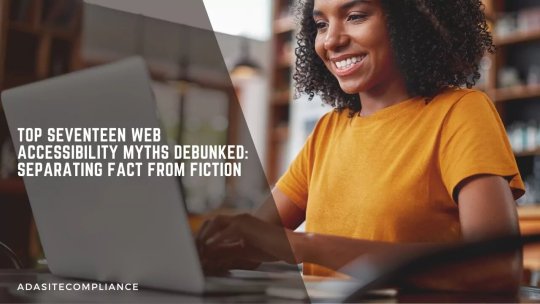
Accessibility Benefits For Businesses
ADA Site Compliance shows the benefits of accessibility for businesses!
#Web Accessibility Myths#Digital Accessibility#ADA Compliance#WCAG Compliance#Inclusive Web Design#Accessibility Testing Tools#Assistive Technologies#Accessible Website Design#Web Compliance#Accessibility Guidelines#Accessibility Misconceptions#Keyboard Navigation#Alt Text for Images#Accessibility Overlays#Color Contrast#website accessibility solutions#ADA site compliance#ADASiteCompliance#adasitecompliance.com
1 note
·
View note
Text
Accessible Website Design
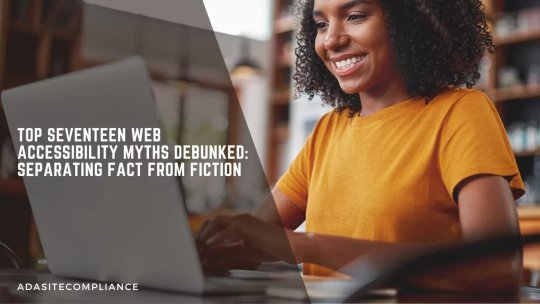
Top Seventeen Web Accessibility Myths Debunked: Separating Fact from Fiction
Accessibility is no longer a ‘luxury’.
Incorporating accessibility into a website today comes part and parcel with web development. With the internet harboring users with and without disabilities who use it for information, bookings, enrollments, purchases, and even jobs, websites need to be compliant.
Unfortunately, many aren’t because some misconceptions and myths cause confusion and hesitance to hinder progress. So here’s an attempt at separating fact from fiction by debunking the top 17 common web accessibility myths.
Remember, web accessibility is no longer just a legal requirement; it’s part of digital inclusivity. It increases your reach and demonstrates your commitment to serving everyone in your community.
If achieving compliance seems overwhelming, we at ADA Site Compliance can simplify things for you. Our team of accessibility experts can help you meet these requirements while you focus on your core business.
Top 17 Web Accessibility Myths Debunked
Let’s now examine these widely misinterpreted web content accessibility principles and guidelines. At the end of the article, you will realize that all those misconceptions you had about web compliance are just myths.
Myth #1- Web Accessibility is Only for Blind People and Users with Visual Impairments
False.
Other people with varied disabilities, such as deafness, limited motor skills, and cognitive limitations, also visit websites for various reasons. An accessible website gives them access to the information they seek, ensuring your website reaches more people.
Myth #2- Web Content Accessibility Guidelines Compliance Ensures Digital Accessibility
False.
Yes, the WCAG provides a framework to enhance digital accessibility. However, compliance alone is not enough for a completely accessible website. Website owners and developers must understand and implement the WCAG principles, as factors like cumbersome user interfaces, poor content, and insufficient testing can lead to incompliant websites.
Myth #3- Accessibility is Only About Making Websites Accessible
False.
Accessibility applies to other digital assets, including mobile applications, PDFs, and other digital documents. Organizations must thus ensure accessibility across all digital platforms for inclusive digital experiences.
Myth #4- Accessibility is Only Relevant for Disabled People
False.
It is not just people with disabilities that benefit from website accessibility. Digital compliance features benefits extend to broader groups, including:
Older adults facing sensory or cognitive challenges as they age
Individuals with temporary disabilities due to injury, illness, or surgery
People experiencing situational limitations, like background noise
Non-native speakers struggling with language barriers hindering understanding and engagement
Myth #5- Accessibility Means Redesigning a Less Visually Appealing Website
False.
Many businesses believe digital accessibility requires a complete website overhaul or poor visual appeal, which is far from the truth. Minor adjustments can significantly create an accessible digital experience without significant redesign efforts.
Myth #6- Digital Accessibility is Only a Concern for Large Corporations
False.
Size is not a criterion for digital accessibility; failure to meet the many digital accessibility laws can lead to legal repercussions and damage a company’s reputation.
Small businesses may face resource constraints, but the numerous tools and online resources can help them understand and ensure web compliance. Embedding accessibility practices from the start ensures web compliance for companies of all sizes.
Myth #7- Accessibility Limits Websites to Text-Only Content
False.
The myth that accessible websites must be plain, text-heavy, and free of multimedia elements stems from earlier text-based web pages. However, modern standards allow visually engaging, multimedia-rich websites that meet diverse accessibility needs.
Strategies like adding alt text for images and captions and transcripts to videos ensure compatibility with assistive technologies. It not only supports users with disabilities but also enhances everyone’s user experience.
Myth #8- All It Takes Is A Quick Technical Fix For an Accessible Website
False.
Web compliance is more than a simple technological adjustment. True accessibility is not just a developer’s responsibility but the joint effort of various teams, including design, testing, and content creation. Relying solely on automated tools or accessibility overlays does not ensure comprehensive accessibility.
Myth #9- Accessibility Can Be Addressed Last-Minute with Simple Fixes
False.
While adding elements like alt text at the last minute may seem convenient, genuine accessibility requires careful planning and integration. Last-minute changes usually require significant counterproductive restructuring, which may harm the user experience, especially for those requiring accessible design.
Besides, including alt text in sites is only one piece of the accessibility puzzle. A truly compliant website involves various other steps, including:
Semantic HTML tags to structure content and enhance readability and interaction.
Keyboard Navigation of the website.
Color Contrast to make text and images readable.
Focus Management highlights elements currently in use for better navigation and clarity.
Using Selective ARIA when necessary to support assistive technologies, as overuse can create confusion.
An accessible design demands proactive attention to these elements throughout development rather than depending on quick fixes at the end.
Myth #10- Accessibility is Expensive and Time-Consuming
False.
Integrating accessibility into an existing website can seem complex, require multiple resources, and be time-consuming. However, prioritizing accessibility from the start can significantly reduce most associated challenges.
In fact, with the right planning and skilled development teams, accessibility can be achieved with minimal additional time and resources as an integral part of the development process.
AI-powered accessibility tools also make digital accessibility more affordable and accessible for all website owners to use and ensure websites are accessible for individuals with disabilities. They help achieve substantial accessibility improvements in just a few hours by automating the detection and correction of many common accessibility issues.
Myth #11- Achieving Web Accessibility Is Overly Complicated
False.
Web accessibility standards can seem complex, but their implementation is not complicated. Multiple tools and resources are available to help developers and website owners ensure digital accessibility.
It is better to start with basic principles, such as providing alternative text for images and ensuring keyboard navigation, and then later delve deeper into more advanced techniques.
Besides, remember that automated accessibility testing alone cannot guarantee complete digital accessibility. Automated tools can help identify issues such as color contrast and structural errors.
However, they cannot fully address complex challenges like unclear language and intricate site designs. Human review by accessibility experts is crucial in ensuring website compliance.
Myth #12- Accessibility is Just a “Nice-to-Have” Feature
False.
Ensuring website compliance is not an option; it is a strategic move with significant potential to impact your business success. An accessible website can do a lot for your business, such as attracting a larger audience, driving higher revenue, enhancing brand reputation, and mitigating legal risks.
Besides, with legal scrutiny, accessibility can no longer be an option. A website owner does not want a lawsuit, considering the financial and reputational risks of overlooking accessibility efforts.
Myth #13- Accessibility is All About Avoiding Legal Trouble
False.
Contrary to popular belief, accessibility is not only about meeting legal requirements to avoid lawsuits. Legal compliance is essential, but its benefits extend far beyond this. For example, implementing accessible design dramatically enhances user experience and boosts your brand’s reputation.
Besides, accessible content opens your entire website or application to a broader audience, ultimately increasing user satisfaction and building loyalty.
Myth #14- Digital Accessibility is Optional
False.
Accessibility is more than an option; it is a requirement in many countries, enforced through laws and regulations. It may not be the top priority for all website owners, but digital compliance is essential for ethical reasons and for creating an inclusive experience for everyone.
Following accessibility standards helps meet legal obligations and ensures your website reaches a broader audience, including individuals with disabilities.
Myth #15- It’s Better To Have Separate Websites for Disabled Users
False.
It was previously thought that having a separate website for users with disabilities ensured accessibility for disabled people. However, this strategy is ineffective and biased, as managing multiple websites is expensive and work-intensive and can lead to content and performance discrepancies.
It is, instead, better to design and develop a website that is inherently accessible to everybody from the beginning.
Myth #16- Accessibility is a One-Time Fix
False.
Many people think digital accessibility is a one-time fix, with nothing else to do once experts ensure compliance. This misconception has led to poorly designed products that users cannot effectively access.
On the contrary, web compliance requires constant commitment and oversight, with continual integration of accessibility features from the initial design through ongoing maintenance. Website owners and developers must regularly review and update the website to meet evolving accessibility standards and user needs.
Myth #17- Only Disabled Individuals Can Test To Ensure Accessibility
No, this is false.
Disabled individuals who frequently rely on assistive technology are effective accessibility testers. However, they are not the only people equipped to evaluate accessibility. All that is needed are the proper training and accessibility testing tools to become adept at identifying and addressing accessibility issues.
Closing thoughts
Dispelling these seventeen myths should inspire a more inclusive web design and development mindset. Remember, accessibility is a legal requirement and moral commitment to making the digital world available to everyone, regardless of individual abilities.
By prioritizing accessibility in our choices, we can create a more equitable, user-friendly online experience for all. It also increases your reach and demonstrates your commitment to serving everyone in your community.
Do not worry if achieving compliance seems overwhelming. We at ADA Site Compliance can simplify things for you. We have a team of accessibility experts who can help you meet these requirements while you focus on your core business!
#Web Accessibility Myths#Digital Accessibility#ADA Compliance#WCAG Compliance#Inclusive Web Design#Accessibility Testing Tools#Assistive Technologies#Accessible Website Design#Web Compliance#Accessibility Guidelines#Accessibility Misconceptions#Keyboard Navigation#Alt Text for Images#Accessibility Overlays#Color Contrast#website accessibility solutions#ADA site compliance#ADASiteCompliance#adasitecompliance.com
0 notes
Text

Legal Compliance For Video Accessibility
ADA Site Compliance ensures legal compliance for video accessibility through our audio description services, meeting all required standards and regulations!
#audio description#video accessibility#visually impaired viewers#enhancing video accessibility#standard audio description#extended audio description#live audio description#inclusive viewing experience#spoken narration for visual elements#accessible content#accessibility standards#visual media accessibility#section 508 compliance#audio description benefits#visual impairment#accessible storytelling#narration of visual elements#legal compliance for video accessibility#creating audio descriptions#accessible multimedia content#audio description technology#audio description services#website accessibility solutions#ADA site compliance#ADASiteCompliance#adasitecompliance.com
0 notes
Text
Enhancing Video Accessibility
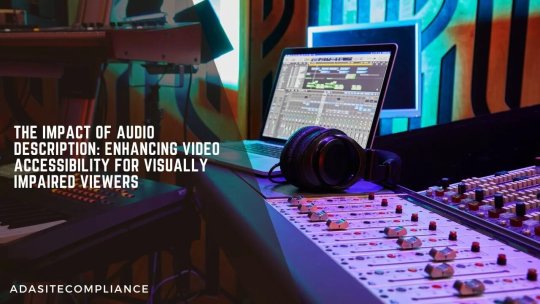
The Impact Of Audio Description: Enhancing Video Accessibility For Visually Impaired Viewers
How do people with visual impairments experience the world of movies and television? Have you ever considered what it’s like to watch a film without seeing the vibrant colors, intricate expressions, or stunning landscapes that make up the visual narrative? In this article, you will learn about the impact of audio description, and how enhancing video accessibility helps to people with visual impairment.
For many with visual impairments, this can lead to disconnection as they miss out on the crucial visual elements that bring a story to their life.
This is where the power of audio description steps in.
Audio description is a groundbreaking technology that provides a spoken narration of the visual elements in movies and TV shows.
It transforms the viewing experience, offering a rich, detailed verbal depiction for those with visual impairments to engage with the story.
It creates an inclusive experience about genuinely participating in the narrative, which is why it is necessary in today’s digital age. Ensuring content is accessible through audio description is a commitment to inclusivity and equality.
At ADA Site Compliance, we understand the critical importance of accessible content. Our team of experts is ready to help you ensure your videos meet the highest accessibility standards, including optimized audio descriptions. Let us work together to ensure your content reaches and resonates with all audiences.
What Is an Audio Description?
Audio description provides a spoken narration of visual elements in media, including movies, television shows, and live performances. This service helps blind or visually impaired individuals better understand and enjoy the content, enhancing their overall experience.
It vividly portrays actions, images, gestures, and settings, enabling visually impaired viewers to follow the flow of events, grasp the emotional character undertones, and appreciate the storyline nuances.
Besides, adding audio descriptions also benefits distracted viewers or viewers who find it difficult to focus on the film’s visual aspects. The additional narrative context and richness enhance the viewing experience for a broader audience, making it an indispensable tool for truly inclusive media.
Understanding the Types of Audio Description for Visual Media
Audio description comes in various forms, each tailored to different types of content and specific viewing needs.
1. Standard Audio Description
This is the most widely used format. It delivers concise narrations of key visual elements during natural pauses in dialogue. It ensures a seamless and uninterrupted viewing experience, allowing the narrative to flow smoothly without disrupting the content’s rhythm.
2. Extended Audio Description
Extended audio descriptions offer a more detailed description and narration for intricate visuals or fast-paced action. It goes beyond the basics, providing in-depth explanations of the setting, characters, and actions to give viewers a fuller understanding of the visual subtleties crucial to the storyline.
3. Internet and Interactive Media Audio Description
These descriptions make web pages and multimedia content accessible by covering visual elements such as images and graphics. They thus make digital content more inclusive for users who are blind or use screen readers or other assistive technologies.
They ensure fully accessible pre-recorded multimedia content by meeting essential accessibility standards like the W3C WCAG, Section 508, and EU regulations.
4. Live Audio Description
These descriptions are more in real-time settings like theater performances or live sports events, offering detailed costumes and scene changes or field actions. Like sports commentators, trained narrators describe actions on stage or the field, focusing more on visual details.
The live audio description brings immediacy and engagement to live events for those who might otherwise miss out on the visual aspects.
Each audio description type plays a vital role in making content accessible and enhancing the viewing experience for visually impaired audiences.
Six Advantages of Audio Description Services
By providing detailed explanations of visual elements, audio description ensures that everyone can fully engage with and appreciate the content. Accessibility for visually impaired individuals prevents their exclusion from films, television, and other visual media.
Here are some critical advantages of audio description accessibility:
Enhanced Accessibility: Audio description significantly expands the reach of your content, making it accessible to a large audience of visually impaired individuals.
Increased Versatility: Audio descriptions add flexibility to how your content is consumed. Audiences can enjoy your material by listening while multitasking.
Improved Language Acquisition: Audio description helps with language development in individuals with autism. Linking words with visual elements enhances vocabulary, comprehension, and overall language skills.
Better Understanding of Social Cues: Audio description helps individuals with autism better understand the emotional and social cues conveyed through facial expressions and body language.
Enhanced Auditory Learning: For many, auditory learning helps absorb the essential visual elements that may be unknowingly missed. Audio description enhances the auditory learning experience, making it easier to retain information and grasp complex topics.
Legal Compliance: In many cases, audio description is legally needed to ensure content accessibility for individuals with disabilities. Failing to comply with these accessibility standards can lead to costly legal repercussions.
By incorporating audio description into your web content accessibility guidelines, you improve accessibility and affirm your commitment to diversity and equal opportunity for all.
How to Create Audio Description?
Creating audio descriptions is a meticulous process, and following these five essential steps helps truly enhance accessibility:
Step 1: Conduct a Comprehensive Content Analysis of All Visual Elements
Begin by thoroughly reviewing your video and identifying all significant visual elements that require explanation. This includes actions, facial expressions, scene transitions, on-screen text, sound effects, and other components contributing to the story or understanding.
Step 2: Draft a Clear and Concise Script
The next step is to craft an easy-to-understand script with a video description of important visual elements. It should seamlessly blend with the existing audio track without technical jargon. Use the present tense to create audio descriptions while maintaining a sense of immediacy. Break down complex scenes into smaller, digestible segments, and keep the script engaging and informative.
Step 3: Record the Audio with the Help of a Professional Voice Artist
Engage a skilled voice artist experienced in audio description to record your script. Their clear and articulate delivery and descriptive narration in the desired pace, tone, and style enhance the listening experience.
Step 4: Edit and Synchronize the Audio Description As Appropriate
Carefully edit the recorded audio description to align with the video timing and fit into the pauses in dialogue and background sounds. Review the extended description script for inconsistencies, errors, or unclear sections and make necessary adjustments for a smooth and coherent flow.
Step 5: Conduct Rigorous Quality Assurance
Evaluate the final audio description to ensure clarity, accuracy, and effectiveness in conveying information. Seek feedback from visually impaired individuals or consult accessibility experts to identify potential issues or missing essential visual audio elements. Revise as needed to guarantee that the audio description meets the highest standards of quality and accessibility.
The Evolution of Audio Description Technology
With the rapid advancement of technology, audio description has seen significant progress, enhancing its effectiveness and reach. Modern tools, innovative software, and refined methods have revolutionized how audio descriptions are created and delivered.
These technological advancements are not just about convenience—they enable individuals with visual impairments to engage with and participate in society.
Essential Tools for Creating High-Quality Audio Descriptions
A meticulously crafted script is the foundation of effective audio description. Some tools offer robust scriptwriting capabilities, including automatic formatting, collaboration features, and version control. These capabilities are indispensable for creating precise and accurate scripts and critical for delivering a seamless and engaging audio description experience.
Once the script is ready, record and refine the audio using tools to capture audio recording, editing, and mastering audio. These applications ensure the final audio description is clear, professional, and fully immersive, enhancing the viewer’s experience.
Accurate transcription is another crucial component of high-quality audio description, and some tools offer fast and reliable transcription services. This allows creators to focus on producing high-quality audio descriptions without wasting time on manual transcription, ensuring that every detail of entertainment audio description is captured accurately.
Future of Audio Description and Accessibility
The future of audio description is promising and evolving rapidly. As technology advances, the quality and accessibility of audio-described content are set to reach new heights. Innovations in AI and machine learning are paving the way for more efficient and accurate creation of audio descriptions, making it easier than ever to ensure that content is accessible to all.
These advancements mean that audio description will become an even more integral part of media creation. However, technology alone is not enough to achieve true accessibility. Collaboration is key. For audio description to reach its full potential, content creators, accessibility experts, and the visually impaired community must work together.
By sharing knowledge, expertise, and experiences, we can drive innovation and make media more inclusive for everyone. This collaborative effort is essential in ensuring that the audio description meets the technical requirements and resonates with the audience it serves.
Audio description is vital to inclusivity, making video content accessible to everyone. It allows visually impaired individuals to engage fully with films and television, fostering a sense of belonging and participation.
At ADA Site Compliance, we are dedicated to helping you create accessible content that meets the highest standards. Our team of experts is ready to assist you in integrating audio descriptions and other essential accessibility features into your videos. Together, we can build a more inclusive future where everyone can enjoy the magic of storytelling!
youtube
#audio description#video accessibility#visually impaired viewers#enhancing video accessibility#standard audio description#extended audio description#live audio description#inclusive viewing experience#spoken narration for visual elements#accessible content#accessibility standards#visual media accessibility#section 508 compliance#audio description benefits#visual impairment#accessible storytelling#narration of visual elements#legal compliance for video accessibility#creating audio descriptions#accessible multimedia content#audio description technology#audio description services#website accessibility solutions#ADA site compliance#ADASiteCompliance#adasitecompliance.com#Youtube
0 notes
Text
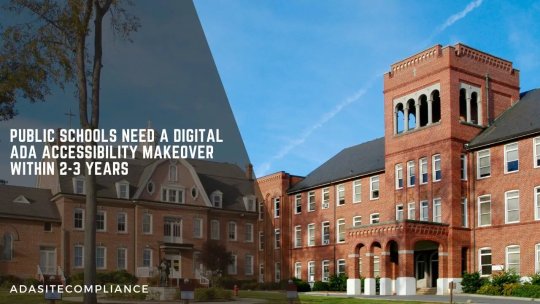
Inclusive Digital Experience
ADA Site Compliance creates an inclusive digital experience for schools, ensuring all students can engage with educational content regardless of their abilities!
#ada compliance for schools#digital accessibility in education#u.s. department of justice#ada title ii#world wide web consortium (w3c)#technical accessibility standards#accessibility features#accessible digital content#accessibility consultants#digital content creation#ada title ii 504 compliance#wcag 2.1 standards#ada compliance deadline 2027#universal design in education#school website#inclusive digital experience#assistive technologies#accessible digital content creation#website accessibility solutions#ADA site compliance#ADASiteCompliance#adasitecompliance.com
0 notes
Text
U.S. Department Of Justice
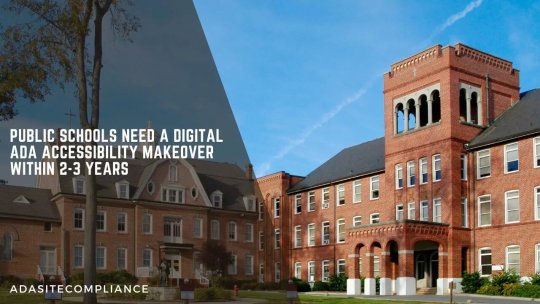
Public Schools Need A Digital ADA Accessibility Makeover Within 2-3 Years
According to a new federal mandate from the U.S. Department of Justice, public schools must make all digital content accessible to students with disabilities.
The U.S. Department of Justice has issued under Title II of the ADA that stipulates compliance with the Web Content Accessibility Guidelines (WCAG) by 2027.
This means schools must ensure that websites, mobile apps, and other digital platforms used for education are usable by students with a wide range of impairments.
The United States Department of Justice has endorsed the WCAG 2.1 to provide clear guidance for ADA compliance for web content and mobile apps.
These guidelines, established by the World Wide Web Consortium (W3C), are recognized globally and offer a comprehensive framework for creating accessible digital experiences. Although W3C released an updated version of these guidelines in 2023, public schools must adhere to the WCAG 2.1 standards from 2018.
Public schools nationwide face a formidable challenge: ensuring all students can access digital resources by 2027. However, navigating the complexities of digital accessibility can be overwhelming for schools.
Meeting the 2027 deadline for compliance while creating an inclusive online environment requires expertise and precision. At ADA Site Compliance, we simplify the process.
Our team ensures your school’s digital platforms adhere to accessibility standards, preventing legal issues and fostering a welcoming environment for all students. Let us help you create a truly inclusive digital experience.
Schools Face Steep Climb to ADA Compliance
Public educational institutions across the U.S. have two or three years, depending on their size, to ensure their web content and mobile apps meet technical accessibility standards adopted in April under Title II of the Americans with Disabilities Act.
Smaller school districts have until April 26, 2027, to achieve compliance, while larger districts exceeding populations of 50,000 have till April 24, 2026, to meet compliance.
Attaining ADA compliance is an uphill battle for many educational institutions.
This requirement has placed significant pressure on school districts, many grappling with limited resources and poor technological expertise.
The standards cover a wide range of accessibility features, including providing alternative text for images, ensuring keyboard navigation, and maintaining adequate color contrast.
That’s why some experts say they should start preparing now. The transition to a fully accessible digital infrastructure is a technical upgrade and comprehensive overhaul of existing systems and practices.
Revamping their digital infrastructure to create inclusive online learning environments necessitates strategic planning, substantial investments, and continuous professional development for staff.
Schools must adopt a phased approach to ensure compliance within the given timeframe. This involves thorough audits of current digital assets, identifying accessibility gaps, and implementing necessary modifications.
These principles are not just technical requirements; they are essential for enhancing the educational experience of students with disabilities and fostering a more equitable learning environment for all.
Accessibility: More Than Just Website Compliance
The shift towards accessibility isn’t solely a technological endeavor for schools. It also demands a cultural change within educational institutions, fostering an environment where inclusivity is a core value.
Professional development opportunities will play a crucial role in this transformation.
Staff must have the knowledge and skills to create and maintain accessible digital content. This includes understanding universal design, becoming proficient with assistive technologies, and staying updated with the latest accessibility standards.
Additionally, schools must allocate budgetary resources to support this initiative. This might include hiring accessibility consultants, investing in accessible technology, and ensuring ongoing maintenance and updates to digital content.
Collaboration with stakeholders, including parents, students, and disability advocacy groups, is essential to address diverse needs and gather feedback on accessibility improvements.
Consequences of non-compliance
The consequence of non-compliance with WCAG is the risk of facing potential legal ramifications with time. The legal fees associated with non-compliance can get expensive, much more than the cost of attaining web compliance.
While the Department of Justice has outlined specific exemptions—such as archival information, legacy papers, content from third parties, social media postings, and password-protected files—it’s important to note that these exceptions are limited and may not apply universally.
Educators must thus thoroughly analyze their digital assets to determine which information falls under these exemptions.
Benefits of accessibility to educational institutions
According to CAST, a leading accessibility organization, this regulatory reform is a significant milestone in the quest for accessibility. By integrating accessibility standards into digital content, educational institutions can offer a more equitable learning environment for students with disabilities.
Furthermore, universal design principles benefit all users by making content easier to understand and navigate. Lindsay Jones, CEO of CAST, underscores that accessibility is not just about compliance; it’s about providing a better user experience for the entire school community.
This emphasis on enhancing user experience is the true driving force behind accessibility.
The Ripple Effect of ADA-Compliance on Student Success
Compliance with ADA Title II 504 is more than just a legal obligation; it’s a commitment to fostering an inclusive and supportive learning environment. Schools that prioritize accessibility adhere to legal standards and are dedicated to educational equity.
This proactive stance can lead to numerous benefits:
Enhanced Student Engagement: Accessible digital content ensures all students can fully participate in educational activities. This inclusivity can lead to higher levels of engagement and academic success.
Improved Academic Outcomes: Studies have shown that when students have access to resources that cater to their individual needs, their academic performance improves. By removing barriers, schools can help all students reach their full potential.
Positive Institutional Reputation: Schools known for their inclusive practices attract a diverse student body and staff. This positive reputation can enhance the institution’s standing in the community and attract more resources and partnerships.
Legal and Financial Safeguards: Proactively addressing accessibility reduces the risk of legal challenges and the associated financial costs. Schools can avoid costly lawsuits and fines by complying with ADA Title II 504.
Equal access for everyone: ADA compliance ensures that students with disabilities have the same access to educational resources as their peers, which is fundamental for their academic success and overall well-being.
Universal design approach: Accessible digital environments benefit all students, as they promote a universal design approach that can accommodate diverse learning needs and preferences.
Digital accessibility extends beyond the classroom: Accessible online learning platforms and resources prepare students for the future, equipping them with the skills to navigate an increasingly digital world.
A Roadmap to ADA Compliance: Nine Essential Steps for Schools
As schools work towards meeting these compliance deadlines, they must also consider the ongoing training and support for educators and staff to use and create accessible digital content.
To effectively comply with ADA Title II 504 within the given timeframe, schools can adopt these nine practical steps:
Conduct Regular Accessibility Audits: Regularly conduct audits of school websites and mobile apps to identify and address accessibility issues. Use both automated tools and manual testing to ensure a thorough evaluation.
Invest in Training: Educate staff about the importance of digital accessibility and provide training on creating and maintaining accessible content. This includes understanding how to use accessibility features in various software and platforms.
Utilize Accessible Technology: Integrate and support using assistive technologies that can aid students with disabilities. Ensure website compatibility with screen readers, voice recognition software, and other assistive tools.
Engage with the Community: Involve students, parents, and community members in the accessibility planning process. Their feedback can provide valuable insights and ensure that the solutions implemented meet the needs of all users.
Incorporate Accessibility in Procurement: When acquiring new digital tools or platforms, ensure they meet WCAG 2.1 standards. Include accessibility requirements in procurement processes to avoid future compliance issues.
Develop an Accessibility Plan: Create a detailed plan outlining the steps to achieve compliance. This plan should include timelines, responsible parties, and measurable goals.
Policy Development: Develop and enforce policies prioritizing accessibility in all digital content creation and management processes. Make accessibility a core component of the school’s digital strategy.
Fostering collaborations: Collaborating with students, parents, and advocacy groups can provide valuable insights and help identify areas that need attention.
Continuous Monitoring and Updates: Accessibility is not a one-time effort. Continuously monitor digital content for compliance and stay updated with the latest accessibility standards and best practices. Implement regular updates to address new accessibility challenges as they arise.
By following these nine steps, public schools can meet the requirements of ADA Title II 504 and also create a more inclusive and supportive learning environment for all students.
As technology evolves, so should our commitment to accessibility, ensuring no student is left behind.
Conclusion
The journey toward compliance with ADA Title II 504 is challenging but an opportunity for schools to enhance their digital offerings and ensure that all students, regardless of their abilities, have equitable access to educational resources.
By embracing this mandate, schools can foster a more inclusive learning environment that supports the diverse needs of their student population. However, meeting the 2027 deadline for compliance while creating an inclusive online environment requires expertise and precision.
At ADA Site Compliance, we simplify the process. Our team ensures your school’s digital platforms adhere to accessibility standards, preventing legal issues and fostering a welcoming environment for all students. Let us help you create a truly inclusive digital experience!
#ada compliance for schools#digital accessibility in education#u.s. department of justice#ada title ii#world wide web consortium (w3c)#technical accessibility standards#accessibility features#accessible digital content#accessibility consultants#digital content creation#ada title ii 504 compliance#wcag 2.1 standards#ada compliance deadline 2027#universal design in education#school website#inclusive digital experience#assistive technologies#accessible digital content creation#website accessibility solutions#ADA site compliance#ADASiteCompliance#adasitecompliance.com
0 notes
Text
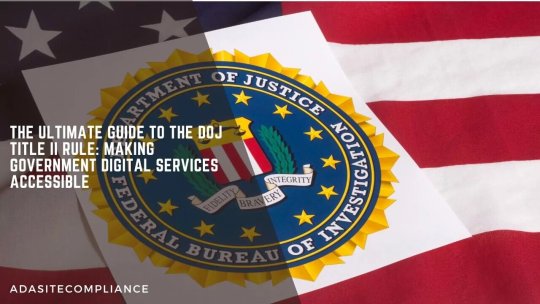
WCAG 2.1 Level AA
ADA Site Compliance ensures digital services meet WCAG 2.1 Level AA standards and DOJ Title II compliance!
#Department of Justice (DOJ)#DOJ Title II#DOJ Title II Rule#new DOJ rule#government digital services accessible#digital services accessible#web accessibility solutions#web & mobile app accessibility#WCAG 2.1 Level AA#WCAG 2.1 standards#DOJ Civil Rights Division#accessibility standards#digital accessibility#accessibility issues#Americans with Disabilities Act (ADA)#ada compliance analysis#website accessibility solutions#ADA site compliance#ADASiteCompliance#adasitecompliance.com
0 notes
Text
DOJ Title II Rule
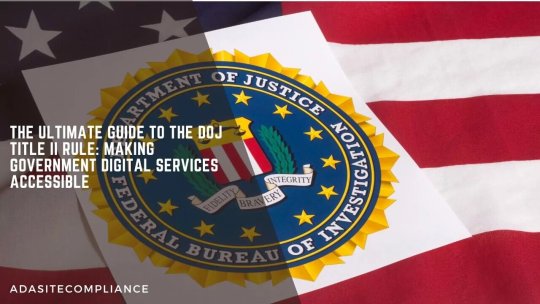
The Ultimate Guide to the DOJ Title II Rule: Making Government Digital Services Accessible
The Americans with Disabilities Act (ADA) has been a cornerstone in transforming public life for individuals with disabilities by ensuring equal access to physical spaces, services, and opportunities. However, as our society increasingly moves online, the digital landscape presents a new frontier of challenges. This article will guide the DOJ Title II rule for making Government digital services accessible for individuals with disabilities.
Despite the ADA’s groundbreaking impact, many government websites and mobile apps remain inaccessible. It creates barriers to essential information and services for people with disabilities. It limits access and undermines ADA principles of equality and inclusivity.
The solution lies in web accessibility to foster a more inclusive society where everyone, irrespective of their abilities, can independently and equally access important information and services. It includes activities like applying for permits and engaging in community programs.
The Department of Justice (DOJ) has played an integral role in enforcing ADA compliance for state and local government entities. Read on to learn more about this, and the new regulations to enhance web accessibility.
Maintaining web compliance can be complex, but it is necessary for compliance and to create an inclusive digital environment. We at ADA Site Compliance can make web accessibility easier for you.
We ensure your websites and mobile apps meet all legal requirements efficiently, bridge the accessibility gap, and demonstrate your commitment to inclusivity.
Accessibility Standards – What You Need To Know
The DOJ Title II Rule clearly defines accessible web content and mobile apps.
The regulation adopts Website Compliance Accessibility Guidelines (WCAG) 2.1 Level AA to ensure digital content is perceivable, operable, understandable, and robust for users with disabilities.
These guidelines list the requirements for web compliance that include using alt text descriptions for images, providing keyboard accessibility for navigation, and using clear language to enhance comprehension.
The state and local governments create truly inclusive digital platforms through the WCAG like:
• Alternative text descriptions that allow screen readers to understand visual content
• Keyboard accessibility for individuals with motor disabilities to navigate websites without a mouse.
• Clear and straightforward language that makes information easier and more accessible to users with cognitive disabilities.
Affected Parties
The new DOJ rule majorly impacts United States state and local government entities. According to the Department, about 109,893 state and local government websites and 8,805 mobile applications face the impact.
91,489 state and local government bodies manage these digital platforms that must review and upgrade their online content and mobile apps to comply with WCAG 2.1 Level AA standards. This widespread impact ensures uniform digital accessibility across various governmental levels.
The Implementation Process
In addition to setting accessibility standards, the DOJ Title II Rule also outlines its implementation process. First and foremost, users with disabilities can legally file complaints with the DOJ’s Civil Rights Division if they encounter inaccessible web content or mobile apps.
The rule itself does not specify penalties.
The DOJ investigates these complaints and accordingly pursues injunctive relief for compliance. So non-compliant public entities may be legally required to make their digital platforms accessible.
The DOJ also provides the following support to help state and local governments implement new regulations for a smooth transition into compliant digital platforms:
• Technical assistance
• Online resources
• Training sessions
• Webinars to help entities understand and meet accessibility requirements.
Key Provisions of the New Rule
Adhering to the WCAG significantly enhances the accessibility of state and local government websites and mobile applications. This step to ensure all users have equal access to essential information and services fosters inclusivity and equity in the digital realm.
All state and local government entities can’t achieve web compliance overnight. Knowing this, the DOJ has established specific deadlines for compliance varying depending on the size of the public entity. They are:
• Entities with Fewer than 50,000 People / Special District Governments: These smaller entities have till three years of publishing the final rule to reach compliance. Their extended timeline provides them enough time to implement the required accessibility changes without much pressure, considering their limited resources and capabilities.
• Entities with 50,000 or More People: Larger entities typically have till two years of publishing the final rule to reach compliance. They have a year shorter to meet compliance as their increased operational capacity lets them quickly adapt their web content and mobile apps.
With these staggered deadlines, the DOJ provides a phased and manageable for public entities of all sizes to approach compliance with a smoother transition and better allocation of resources.
Specific Exceptions from Compliance
As entities begin to navigate this process, understanding the specific exceptions from compliance becomes crucial. Yes, it is after recognizing the potential challenges in some cases, that the DOJ has outlined five exemptions where compliance is not mandatory:
1. Archived Web Content
Websites containing archived materials like old meeting minutes or historical documents are often no longer actively used. So they are exempt from the compliance requirement unless someone with a disability makes a request.
2. Preexisting Conventional Electronic Documents
Any old documents created and stored for reference on a website are exempt from compliance. However, old documents presently used for application, gaining access to, and participation in any public entity’s service, program, or activity must meet accessibility requirements.
3. Third-Party Content
Any content posted by third parties is exempt from the compliance requirements unless posted on behalf of the public entity as per contractual, licensing, or other arrangements. This exemption is because public entities have no control over content generated on their platform by independent third parties.
4. Password-Protected Conventional Electronic Documents
Password-protected or secured documents, related to a specific individual, their property, or their account, are exempt from compliance. It is to protect sensitive personal information and the challenges in making such content accessible.
5. Preexisting Social Media Posts
Social media posts made before the new rule implementation are exempt from compliance. The exemption is because of the transient nature of social media content and the impracticality of making all historical posts accessible.
Handling of Accessibility Requests
The DOJ mandates that, if necessary, people with disabilities have the right to request public entities to provide accessible versions of exempt content. So someone with low vision needing to access some archived documents can make a request. It ensures visitors with disabilities can access critical information or services they require, even for exempted content.
Estimated Costs for Digital Accessibility
With substantial costs associated with implementing the new rule, the DOJ has provided estimates to help entities assess their potential financial burden of compliance. The annual costs over a decade are estimated to be between $3.3 billion and $3.5 billion, at 3% and 7% discounted rates, respectively. These costs include:
Implementation Costs:
The first three years of implementation costs to ensure digital platforms are accessible to everyone may approximately cost $16.9 million (undiscounted). These costs include cost for:
• Updating websites and mobile applications to meet WCAG 2.1 standards
• Staff training
• The necessary tools and technologies
Ongoing Maintenance Costs:
In addition to the initial implementation period, the projected annual O&M costs for the next seven years, are $2.0 billion. These ongoing expenses cover the costs to ensure digital content remains accessible and compliant with WCAG 2.1 and include:
• Regular audits
• Updates to website and mobile app content
• Continuous training for staff to maintain accessibility standards.
The state and local government entities can better prepare and allocate their budgets now that they know the associated compliance costs. This proactive approach facilitates a smoother implementation and helps manage long-term costs to maintain compliance.
Repercussions of Non-Compliance
Digital accessibility is mandatory to ensure everyone can access digital content and mobile apps. It lets all internet users have no difficulties accessing essential information and services.
With it playing such an important role, non-compliance comes with its repercussions. Web developers and website owners who do not ensure their digital content is compliant face the following consequences:
1. Legal Consequences
Public entities may face lawsuits from individuals or advocacy groups, making them meet accessibility standards. Non-compliance with the new DOJ rule can lead to significant legal ramifications resulting in:
• Substantial fines
• Legal fees
• Exorbitant lawsuits
• Other associated costs
These legal actions can leave a considerable financial burden on public institutions.
2. Financial Impact
These legal penalties are not the only financial repercussions public entities face for non-compliance. The financial impact that makes non-compliance financially unviable includes:
• Higher costs due to rushed remediation efforts
• Expensive emergency spending to address accessibility issues under pressure
• The cost of regaining lost public trust and reputation can be substantial
3. Reputation and Trust
Non-compliance can lead to public outcry and a loss of trust, thus severely damaging an entity’s reputation, especially among individuals with disabilities and advocacy groups. The loss of trust can have long-lasting effects, especially amongst people with disabilities and advocacy groups, as they lose confidence in the entity’s commitment to inclusivity and equal access.
Besides, a damaged reputation can also impact the entity’s ability to serve its community.
4. Operational Challenges
Legal battles and the need for urgent compliance measures can disrupt the public entity’s operations. The diversion of resources and attention from other critical projects to address the accessibility issues can lead to operational inefficiencies and reduce the overall effectiveness of the entity’s services.
In short
The DOJ Title II Rule ensures digital accessibility and equality for individuals with disabilities. The clear standards and enforcement mechanisms set a national precedent for digital inclusion.
However, the field of digital accessibility continually evolves as technology advances. The DOJ has to constantly update the guidelines and requirements per the latest practices and innovations.
To stay compliant and foster an inclusive digital environment, state and local governments, web developers, and designers must remain informed about these changes.
Regular reviews and updates for digital content and platforms according to the latest accessibility standards ensure everyone has equal access to their content. This dedication to accessibility contributes to creating a more inclusive society where everyone can participate fully in public life.
Maintaining web compliance can be a complex task, but it is necessary for compliance and to create an inclusive digital environment. ADA Site Compliance makes web accessibility easier for you.
We ensure your websites and mobile apps meet all legal requirements efficiently, bridge the accessibility gap, and demonstrate your commitment to inclusivity!
#Department of Justice (DOJ)#DOJ Title II#DOJ Title II Rule#new DOJ rule#government digital services accessible#digital services accessible#web accessibility solutions#web & mobile app accessibility#WCAG 2.1 Level AA#WCAG 2.1 standards#DOJ Civil Rights Division#accessibility standards#digital accessibility#accessibility issues#Americans with Disabilities Act (ADA)#ada compliance analysis#website accessibility solutions#ADA site compliance#ADASiteCompliance#adasitecompliance.com
0 notes
Text
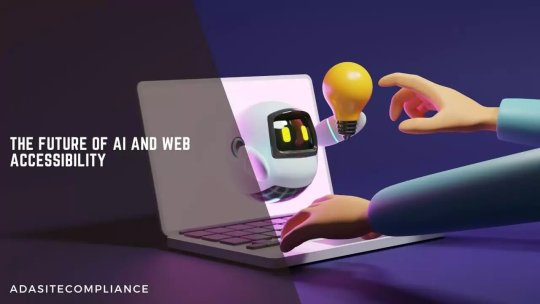
Digital Content Accessibility
Discover ADA Site Compliance's solutions for digital content accessibility, ensuring inclusivity online!
#AI and web accessibility#ChatGPT-3#GPT-4#GPT-5#artificial intelligence#AI influences web accessibility#AI-powered tools#accessible technology#tools and solutions#machine learning#natural language processing#screen readers accessibility#voice recognition#speech recognition#image recognition#digital accessibility#alt text#advanced web accessibility#accessibility compliance#accessible websites#accessibility standards#website and digital content accessibility#digital content accessibility#free accessibility scan#ada compliance tools#ada compliance analysis#website accessibility solutions#ADA site compliance#ADASiteCompliance#adasitecompliance.com
0 notes
Text
AI Influences Web Accessibility

The Future Of AI And Web Accessibility
In our increasingly digital world, equal access to information is crucial. However, many individuals with disabilities face challenges in accessing online content, such as websites, articles, and videos, due to various barriers.
Imagine a world where technology empowers everyone to access information effortlessly, regardless of their abilities. Thanks to artificial intelligence (AI), this vision is becoming a reality. AI is breaking down barriers and making technology more accessible.
By improving information accessibility, AI not only aids individuals with disabilities but also enhances the overall user experience for everyone. ChatGPT-3 has accelerated AI-driven innovation, and while the future of AI and website accessibility is unknown, innovative technologies like GPT-5 have immense potential to enhance accessibility.
We at ADA Site Compliance have a team of accessibility experts who stay updated with the latest regulatory trends and emerging technology. They help organizations like yours ensure that all digital content meets accessibility standards.
Exploring the Future Potential of Artificial Intelligence
Artificial Intelligence (AI) involves creating computer systems designed to mimic human intelligence. A fundamental aspect of AI is machine learning algorithms, a subset that allows computers to learn and evolve based on experience without explicit programming.
Technological advancements have unlocked AI’s vast potential, enabling intelligent devices to perform tasks that once were solely within the realm of human cognition.
What is AI?
To grasp how AI influences web accessibility, we first need to define it.
Artificial Intelligence involves developing software and systems that perform tasks requiring human intelligence. AI achieves this through various technologies, including natural language processing and computer vision. As these functions become more accessible, they benefit society even more
What Are Accessibility Technologies?
Accessibility technologies provide tools and solutions to ensure that people with disabilities can access and use web content effectively. These technologies, including AI-powered tools like chatbots, digital platforms like GPT, screen readers, and alternative input devices, are designed to enhance digital accessibility and foster inclusivity.
Current AI Technologies
AI is rapidly enhancing web accessibility. Improved computer vision algorithms are making it easier for visually impaired users and seniors to understand web content through better descriptions of visual content.
Here are a few examples of current AI technologies:
1. GPT-4:
OpenAI’s newest chatbot, GPT-4, enhances accessibility for third-party companies. In partnership with Be My Eyes, GPT-4 introduces an AI-powered Virtual Volunteer to assist visually impaired individuals.
2. Apple’s Accessibility Features:
Apple continues to set the standard in accessibility with a suite of new tools launched on Global Accessibility Awareness Day. These enhancements include improved Voice Control, customizable Siri options, and a unique Assistive Access mode to simplify device usage for people with motor or cognitive disabilities.
3. Google’s Enhanced Navigation Features:
In October, Google upgraded its navigation features for Google Maps and business pages. These enhancements include wheelchair-accessible walking routes, improved Live View for visually impaired users, and a new identity attribute label to help locate disabled-owned businesses.
4. Natural Language Processing (NLP):
NLP enhances text readability, aiding individuals with cognitive disorders, learning disabilities, and age-related cognitive decline.
Despite these advancements, this cutting-edge technology is not yet perfect. Image recognition still struggles with complex scenes and context, and NLP-based text simplification can sometimes lead to a loss of significance. Nevertheless, these developments represent a promising beginning for enhanced digital accessibility.
Examples of How AI Enhances Digital Accessibility
Individuals with visual, auditory, or mobility impairments often face challenges in navigating the digital landscape of the web. Here are some ways AI is making accessibility improvements:
1) Speech Recognition
Speech recognition technology is incredibly beneficial for those with physical limitations, restricted mobility, or typing difficulties. AI-powered speech and voice recognition technologies enable users to control devices and navigate the web using voice commands, significantly enhancing their online accessibility and overall experience.
2) Enhanced Browsing Experience
Did you know that AI-powered virtual assistants and chatbots can significantly enhance online browsing?
These technologies provide personalized support, helping individuals with disabilities access important information and navigate websites more effectively. Accessible websites perform better in search engines but also offer a superior user experience for everyone.
3) AI-Enhanced Visualization for Visually Impaired Users
Imagine a world where images and text describe everything around you. AI-powered screen readers and text-to-speech technologies make written content accessible for visually impaired individuals. Additionally, image recognition systems can describe photos, videos, and live scenes, offering valuable assistance to those with visual impairments.
A crucial accessibility element for visually impaired users is “alt text.” AI can automatically generate alt text for images and videos, ensuring quick and accurate descriptions that describe images. This allows screen readers to interpret and explain on-screen images, making web content more inclusive and accessible.
AI Benefits for Web Accessibility
AI is revolutionizing web accessibility, offering numerous benefits that enhance the online experience for individuals with disabilities. Here are some key advantages AI brings to web accessibility:
a) Enhanced Access
AI has significantly advanced web accessibility for individuals with disabilities. It removes obstacles, enabling users to navigate websites, consume multimedia content more, and engage in online communities more effectively.
b) Boosted Independence and Autonomy
AI empowers individuals with disabilities to use the internet independently. This innovation allows them to manage their online activities without assistance, fostering greater inclusion and promoting autonomy.
Challenges Posed by AI on Web Accessibility
AI enhances online accessibility, but it also introduces several challenges. Here are some key issues AI poses for web accessibility:
i) Accuracy Challenges
Despite advancements, AI often struggles with providing reliable captions, descriptions, translations, and voice recognition. Errors in these areas can make it difficult for users to understand content, thereby limiting the effectiveness of accessibility features.
ii) Over-Reliance
Relying too heavily on AI to improve web accessibility can result in overlooking other essential aspects of accessible design. Use AI alongside comprehensive other accessibility guidelines and principles and not seen as a universal solution.
Future of AI-Driven Web Accessibility
With AI becoming more advanced, it will continue enhancing technology usability and improving web accessibility. Developers will save time and resources when using these tools to discover and fix accessibility issues.
Remember that automated tools cannot guarantee accessibility compliance.
Human knowledge and manual testing by experienced accessibility auditing specialists will still be needed to discover complicated issues and create a fully inclusive user experience for elders and disabled people.
This is where we at ADA Site Compliance can help. We have a team of accessibility experts and web developers who stay updated with the latest regulatory trends to help organizations like yours ensure all web content meets accessibility standards.
For all your website and digital content accessibility needs, contact ADA Site Compliance today!
#AI and web accessibility#ChatGPT-3#GPT-4#GPT-5#artificial intelligence#AI influences web accessibility#AI-powered tools#accessible technology#tools and solutions#machine learning#natural language processing#screen readers accessibility#voice recognition#speech recognition#image recognition#digital accessibility#alt text#advanced web accessibility#accessibility compliance#accessible websites#accessibility standards#website and digital content accessibility#digital content accessibility#free accessibility scan#ada compliance tools#ada compliance analysis#website accessibility solutions#ADA site compliance#ADASiteCompliance#adasitecompliance.com
1 note
·
View note
Text
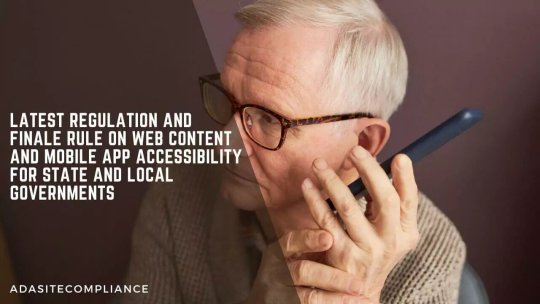
ADA Standards For Accessible Design
ADA Site Compliance specializes in implementing ADA standards for accessible design on your digital platforms!
#Websites and mobile app accessibility#web and mobile app accessibility#Americans with Disabilities Act (ADA)#ADA standards#Title II of the ADA#online services and mobile applications#state and local governments#accessibility standards#ADA standards for accessible design#ADA-compliant websites#WCAG 2.1 Level AA#WCAG 2.1 AA standards#WCAG standards#WCAG 2.1 Level AA accessibility standards#WCAG Version 3.0#digital content#digital resources#free accessibility scan#ada compliance tools#ada compliance analysis#website accessibility solutions#ADA site compliance#ADASiteCompliance#adasitecompliance.com
0 notes
Text
Americans With Disabilities Act (ADA)
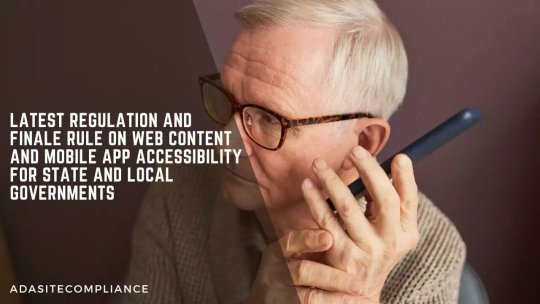
Latest Regulation And Finale Rule On Web Content And Mobile App Accessibility For State And Local Governments
In a significant advancement for digital inclusivity, Attorney General Merrick B. Garland has enacted a critical update under Title II of the Americans with Disabilities Act (ADA). This new regulation compels state and local governments to ensure their websites and mobile app accessibility for individuals with disabilities.
Considering the integral role of digital platforms in providing access to services such as emergency responses, healthcare, voting, and public transit, the lack of accessibility could significantly prevent disabled individuals from accessing necessary services.
This rule clarifies governmental bodies’ responsibilities and highlights the imperative for businesses to adjust, even amidst evolving compliance landscapes.
ADA Site Compliance works to help companies comply with regulatory mandates. With a dedicated team that monitors regulation updates, we ensure businesses confidently maintain websites that meet current accessibility standards.
Statements from Justice Department Officials
Attorney General Merrick B. Garland: Emphasized the rule’s role in fulfilling ADA’s promise for equal participation. He stated that by establishing definitive digital accessibility standards for state and local governments, they support the ADA’s mission of ensuring full and equal participation for people with disabilities. He also commended the diligent efforts of the Civil Rights Division in implementing this rule.
Acting Associate Attorney General Benjamin C. Mizer highlighted the commitment to making digital platforms usable for everyone to participate fully in society.
Assistant Attorney General Kristen Clarke described the rule as groundbreaking, noting that it removes barriers that have historically excluded Americans with disabilities, and ensures equal access to essential online government services like voting and public benefits.
Importance of Web and Mobile App Accessibility
As state and local governments increasingly digitize their services, the accessibility of their web and mobile platforms becomes crucial. Inaccessible websites and applications can exclude individuals with disabilities from accessing vital services.
For example, visually impaired individuals often need screen readers to navigate websites and applications. Governmental sites posting crucial public information in images without alternative text (“alt text”), is inaccessible to blind users.
Such digital barriers can prevent disabled persons from performing essential activities such as securing mail-in ballots, obtaining tax information, or engaging in community events.
The latest regulation aims to guarantee individuals with disabilities have full access to state and local government online services, programs, and activities. This rule also clarifies steps governments take to adhere to ADA standards, ensuring inclusivity and equal access for every community member.
Title II of the Americans with Disabilities Act (ADA)
Title II of the ADA mandates that all services, programs, and activities provided by state and local governments are accessible to individuals with disabilities.
This extensive requirement encompasses everything from adoption services to zoning regulations and includes both online services and mobile applications managed by state and local authorities.
The rule ensures that individuals with disabilities can fully access and benefit from public services, promoting a more inclusive society with an improved quality of life for disabled individuals nationwide.
This includes:
Making public transportation details accessible to visually impaired users, Enabling the deaf or hard of hearing to participate in online educational courses,
Aiding those with manual dexterity issues in navigating web-based services.
Overview of State and Local Government Functions:
State and local governments are essential providers of numerous public services, including:
Offices administering social benefits like food assistance
Educational facilities
Law enforcement agencies at state and municipal levels.
Judicial systems of local and state courts.
Offices overseeing state and local electoral processes.
Public medical facilities
Community resources like parks, recreational facilities, and public transportation systems.
Accessibility standards under Title II apply to all entities within state and local governments, including their various departments, agencies, special purpose districts, Amtrak, and commuter authorities.
Furthermore, state and local governments contracting with third-party organizations, like non-profits managing drug treatment programs, must ensure these entities adhere to Title II’s accessibility standards.
What Constitutes a Rule or Regulation?
Rules or regulations are formal directives issued by a government agency, from laws enacted by Congress. Following the enactment of the ADA, the Department was authorized to develop regulations to articulate the responsibilities outlined in Title II and Title III of the ADA. Typically, these regulations consist of the regulatory text and an appendix.
The Process of Developing a Rule
The Department formulated this rule through a method known as “notice and comment rulemaking.” The process starts with declaring a Notice of Proposed Rulemaking (NPRM), serving the regulation’s initial draft and proposed requirements, and inviting public feedback.
The Department modified the proposed rule based on the NPRM feedback. Detailed descriptions of the public feedback and rule adjustments are in the rule’s appendix.
What are technical standards?
Technical standards are detailed criteria defining accessibility requirements. For instance, the ADA Standards for Accessible Design include specifications like minimum width for doorways to ensure physical accessibility in buildings and ADA-compliant websites.
Requirement for State and local government websites
This regulation covers all web content handled by state or local governments and must conform to WCAG 2.1, Level AA, including content administered by external contractors.
Example: If a county’s website displays a list of local parks and operating hours, it must adhere to WCAG 2.1, Level AA for accessibility, even if a third-party service provider developed and updated the site.
Web content includes text, images, audio, videos, and documents on the internet.
Requirement for State and Local Government Mobile Apps:
Mobile apps used by state and local governments must conform to WCAG 2.1, Level AA standards. It includes all mobile apps provided or accessible by state or local governments, and external parties.
Mobile apps are software applications specifically designed for use on smartphones and tablets. Developed by the World Wide Web Consortium, WCAG standards make web content universally accessible.
Example: Consider a mobile app developed by a city facilitating public parking payments. The app must comply with the WCAG 2.1, Level AA accessibility standards, no matter if the city or a private company manages it.
Going Beyond Standard Compliance with WCAG 2.1, Level AA
State and local governments have the leeway to adopt web content and mobile apps extending beyond the minimum requirements of WCAG 2.1, Level AA.
This provision for “equivalent facilitation” allows using alternative designs, methods, or technologies, if they offer accessibility and usability equal to or greater than mentioned by the standard.
This flexibility is intended to accommodate the adoption of future, potentially more stringent standards while ensuring continued accessibility for individuals with disabilities.
Example: For instance, a state parks department might implement WCAG Version 3.0 for its new mobile app for booking campsite reservations, if it offers better or equivalent accessibility compared to WCAG 2.1, Level AA.
Specific Exceptions to the Rule Explained
There are various situations where there are exceptions to digital content conforming with the rule. They include:
Archived Web Content:
This applies to outdated or unused content stored in archives, such as old reports or documents, that remain unchanged since archiving. However city council minutes and documents created after the compliance deadline must adhere to accessibility standards.
Even PDFs with up-to-date data on county park maps must conform, regardless of archival status.
Pre-existing Conventional Electronic Documents:
This applies to documents like PDFs or Word files on government digital platforms created before the compliance date and not updated or essential for current use.
However, documents posted or updated after the established compliance deadline do not qualify for exemptions. Active-use documents for accessing government services, irrespective of publication date do not qualify either.
Third-Party Content:
Content posted by third parties without a contractual or official arrangement with the government, which the government cannot modify is exempt. However, content directly posted or managed by the government like calendars developed by external companies, updates made by a government vendor, and message boards must meet WCAG 2.1, Level AA standards.
Individualized Documents:
Applies to personal documents like water bills and documents about specific individuals or accounts available in a secure, password-protected format. They can be challenging for immediate accessibility, especially for recipients without specific disability requirements.
Preexisting Social Media Posts:
This includes all social media posts made before the compliance date. However, if a visually impaired person requests information about a social media image from 2023, the government must provide an accessible description for effective communication.
Conclusion
The new regulation marks a significant step forward in ensuring that all individuals, regardless of disability, have equal access to digital resources provided by state and local governments.
This move aligns with the ADA’s long-standing commitment to inclusivity and modernizes public services to be more accessible, enhancing civic engagement and participation across the community.
ADA Site Compliance works to help companies comply with regulatory mandates. With a dedicated team that monitors regulation updates, we ensure businesses confidently maintain websites that meet current accessibility standards. Get your FREE ACCESSIBILITY SCAN here!
#Websites and mobile app accessibility#web and mobile app accessibility#Americans with Disabilities Act (ADA)#ADA standards#Title II of the ADA#online services and mobile applications#state and local governments#accessibility standards#ADA standards for accessible design#ADA-compliant websites#WCAG 2.1 Level AA#WCAG 2.1 AA standards#WCAG standards#WCAG 2.1 Level AA accessibility standards#WCAG Version 3.0#digital content#digital resources#free accessibility scan#ada compliance tools#ada compliance analysis#website accessibility solutions#ADA site compliance#ADASiteCompliance#adasitecompliance.com
0 notes
Text

Benefits Of Website Accessibility
Emphasizing the advantages of making a website accessible to a diverse audience, this description covers the positive outcomes for both users and businesses!
#Website Accessibility Benefits#Web Accessibility#Accessibility Guidelines#WCAG#ADA Compliant#Accessible Websites#Website Accessibility Lawsuits#ada compliance assessment#ada compliance tools#ada compliance analysis#website accessibility solutions#ADA site compliance#ADASiteCompliance#adasitecompliance.com
0 notes